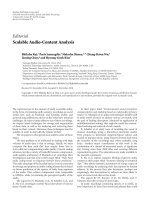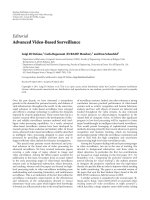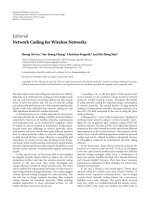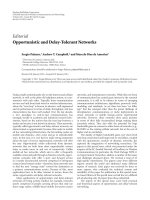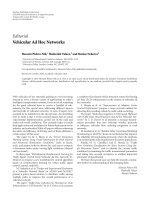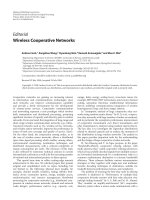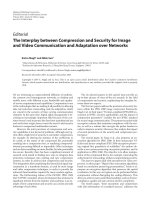Báo cáo hóa học: " Editorial Genetic Regulatory Networks" pot
Bạn đang xem bản rút gọn của tài liệu. Xem và tải ngay bản đầy đủ của tài liệu tại đây (417.54 KB, 2 trang )
Hindawi Publishing Corporation
EURASIP Journal on Bioinformatics and Systems Biology
Volume 2007, Article ID 17321, 2 pages
doi:10.1155/2007/17321
Editorial
Genetic Regulatory Networks
Edward R. Dougherty,
1, 2
Tatsuya Akutsu,
3
Paul Dan Cristea,
4
and Ahmed H. Tewfik
5
1
Depar tment of Electrical & Computer Engineering, College of Engineering, Texas A &M University, College Station,
TX 77843-3128, USA
2
Translation Genomic s Research Institute, Phoenix, AZ 85004, USA
3
Bioinformatics Center, Institute for Chemical Research, Kyoto University, Gokasho, Uji, Kyoto 611-0011, Japan
4
Dig ital Signal Processing Laboratory, Department of Electrical Engineering, “Politechnica” University of Bucharest,
060032 Bucharest, Romania
5
Department of Electrical and Computer Engineering, Institute of Technology, University of Minnesota, Minneapolis,
MN 55455, USA
Received 3 June 2007; Accepted 3 June 2007
Copyright © 2007 Edward R. Doughert y et al. This is an open access article distributed under the Creative Commons Attribution
License, which permits unrestricted use, distribution, and reproduction in any medium, provided the original work is properly
cited.
Systems biology aims to understand the manner in which the
parts of an organism interact in complex networks, and sys-
tems medicine aims at basing diagnosis and treatment on a
systems level understanding of molecular interaction, both
intra-and inter-cellular. Ultimately, the enterprise rests on
characterizing the interaction of the macromolecules consti-
tuting cellular machinery. Genomics, a key driver in this en-
terprise, involves the study of large sets of genes and proteins,
with the goal of understanding systems, not simply compo-
nents. The major goal of translational genomics is to charac-
terize genetic regulation, and its effects on cellular behavior
and function, thereby leading to a functional understanding
of disease and the development of systems-based medical so-
lutions.
To achieve this goal it is necessary to develop nonlin-
ear dynamical models that adequately represent genomic
regulation and to develop mathematically grounded diag-
nostic and therapeutic tools based on these models. Signals
generated by the genome must be processed to character-
ize their regulatory effects and their relationship to changes
at both the genotypic and phenotypic levels. Owing to the
complex regulatory activity within the cell, a full u nder-
standing of regulation would involve characterizing signals
at both the t ranscriptional (RNA) and translational (pro-
tein) levels; however, owing to the tight connection between
the levels, a goodly portion of the information is available
at the transcriptional level, and owing to the availability of
transcription-based microarray technologies, most current
studies utilize mRNA expression measurements. Since tran-
scriptional (and posttranscriptional) regulation involves the
processing of numerous and d ifferent kinds of signals, math-
ematical and computational methods are required to model
the multivariate influences on decision-making in genetic
networks.
Construction of a network model is only the beginning
of biological analysis. Understanding a gene network means
understanding its dynamics, especially its long-run behavior.
For instance, it has been conjectured that the stationary dis-
tribution chara cterizes phenotype. It is in terms of dynamics
that issues such as stability, robustness, and therapeutic ef-
fects must be examined. Indeed, it seems virtual ly impossible
to design targeted treatment regimens that address a patient’s
individual regulatory structure without taking into account
the stochastic dynamics of cell regulation. From the perspec-
tive of systems medicine, perhaps the most important issue
to be addressed is the design of treatment policies based on
the external control of regulatory network models, since this
is the route to the design of optimal therapies, both in terms
of achieving desired changes and avoiding deleterious side
effects.
As a discipline, signal processing involves the construc-
tion of model mathematical systems, including systems of
differential equations, graphical networks, stochastic func-
tional relations, and simulation models. And if we view sig-
nal processing in the wide sense, to include estimation, clas-
sification, automatic control, information theory, networks,
2 EURASIP Journal on Bioinformatics and Systems Biology
and coding, we see that genomic signal processing will play
a central role in the development of systems medicine. There
isahostofimportantanddifficult problems, ranging over
issues such as inference, complexity reduction, and the con-
trol of high-dimensional systems. These represent an exciting
challenge for the signal processing community and a chance
for the community to play a leading role in the future of
medicine.
Edward R. Dougherty
Tatsuya Akutsu
Paul Dan Cristea
Ahmed H. Tewfik
